Wondering which tool is right for you?
When choosing a marketing automation platform, there are a handful of features you expect to encounter. Namely, an intuitive automation builder for users of all levels, advanced email marketing features that make building campaigns easy, and CRM functionality whether that’s with a built-in experience or an integrated one.
Whether you’re looking for powerful automation, seamless CRM functionality, or in-depth lead gen to capture and convert prospects, both ActiveCampaign and RD Station are compelling candidates. The reality is that you’re choosing between a flexible tool that offers advanced automation and email marketing features and a simple tool that lacks powerful automation because of its focus on lead nurturing.
Let’s take a look at the features these platforms offer, who they’re best for, what they’ll cost you, and help you select the one that’s right for you.
ActiveCampaign: the platform that scales with you
ActiveCampaign was founded in 2003 and originally focused on email marketing automation for small businesses. Over time, it grew into a more sophisticated platform, incorporating CRM (customer relationship management) features and advanced automation tools.
Today, it’s known for being a comprehensive marketing automation platform that combines email marketing, sales automation, and customer experience tools.
The platform is particularly recognized for its advanced automation features, including its visual automation builder, dynamic content personalization, and advanced segmentation. It also offers tools for A/B testing, sales pipelines, and detailed reporting, which make it ideal for users looking to create highly targeted and personalized campaigns.
| 93.4% deliverability rate | 250+ email templates |
|---|---|
| 970+ integrations | 10k monthly email sends on Starter |
ActiveCampaign is a great fit for both small and large businesses because it offers the tools you need without overwhelming you with unnecessary extras. The platform is best suited for businesses that need scalable, data-driven solutions with sophisticated automation.
When you switch from to ActiveCampaign, enjoy free 1:1 migration
Adopting a new or switching to another platform can be an undertaking, but it’s inevitable if you’re hitting certain limits with your current tool. When you sign up for an ActiveCampaign Pro or Enterprise plan, we’ll migrate your email lists, transfer your templates, rebuild your automations, and set up your forms and landing pages. All for free.
You’ll get one-on-one sessions with a real person along with resources like help articles and our community to get you set up fast.
ActiveCampaign also provides 24/7 live chat and email support, ensuring you can get help whenever you need it. Their extensive resource library includes webinars, detailed guides, and a community forum, offering a wealth of information to help you navigate and optimize the platform.
RD Station: best for straightforward lead generation
RD Station is a comprehensive digital marketing platform designed to help businesses enhance their online presence with integrated tools for marketing automation, CRM, and social media management. Native to Brazil, it caters especially well to businesses in the Latin American market, offering localized features and resources tailored to regional needs.
Globally, it remains a solid option for companies seeking straightforward marketing solutions.
| Limited selection of email templates | 219 integrations |
|---|---|
| Basic marketing automation | Unlimited monthly email sends on Lite |
A standout feature of RD Station is its focus on lead generation and nurturing. The platform simplifies this process with tools like landing pages, email marketing, and a basic CRM. It’s particularly appealing to small and mid-sized businesses that prioritize capturing and converting leads without needing advanced automation.
Generally, the platform is a good option for businesses looking for a straightforward, lead-driven approach to marketing.
How do ActiveCampaign and RD Station compare?
ActiveCampaign and RD Station are two very different tools and naturally have some key differences. Let’s look at what real customers are saying from a poll Capterra ran of over 4,400 users.
| ActiveCampaign | RD Station | |
|---|---|---|
| Value for money | 4.4 | 3.9 |
| Customer support | 4.4 | 3.9 |
| User satisfaction | 4.6 | 4.3 |
| Functionality | 4.5 | 4.0 |
Source: Capterra
Advanced marketing automation vs. basic workflows
ActiveCampaign’s automation capabilities are incredibly advanced but simple to use. They provide hundreds of "automation recipes" you can use right out of the box and customize with your own tags, custom fields, and content. This means you can easily follow up with customers post-purchase, re-engage those who’ve abandoned carts, or send time-sensitive emails.
Their visual automation builder makes it easy to see complex workflows. You can add actions like “wait,” “if/then” logic, and triggers to shape each contact’s path.

This allows for conditional flows based on specific behaviors, like page visits or specific clicks, making it perfect for in-depth customer journeys. These workflows can include emails, SMS, site messages, and even CRM updates, all from one platform. It's perfect if you're managing both marketing and sales processes since it’s built to handle everything from lead nurturing to post-purchase follow-ups.
ActiveCampaign also allows you to A/B/C/D/E test entire workflows to see which sequence performs better. You can test different email paths, timing, or messages and compare which version drives more engagement or conversions.

This allows you to continuously improve your automations by finding the most effective ways to guide users through the customer journey.
Triggers, actions, and goals are the brain behind ActiveCampaign’s automation. “Triggers” are the conditions that kick off a workflow—like when a lead signs up for a webinar or reaches a certain score in your system. “Actions” are what the system does in response, such as sending a welcome email, tagging the contact, or moving them into a new list. “Goals” let you set milestones within workflows, like getting a contact to register for an event.
ActiveCampaign’s site tracking features let you see what your leads and customers are doing on your website. It records actions like page visits and button clicks, so you know which content or products are catching their interest. Event tracking takes it a step further by tracking specific behaviors you define, like when a customer completes a purchase or fills out a form. This tracking gives you insights to tailor follow-up emails and other interactions based on real-time behavior.

Finally, their sales routing helps you make sure the right sales rep connects with the right leads. Based on factors like the lead’s location, behavior, or score, ActiveCampaign can automatically assign them to a specific rep. This feature helps keep leads from slipping through the cracks and ensures that your team’s follow-ups are fast and organized, which is especially helpful for businesses with high lead volumes.
All of these features make it easy to automate personalized experiences and ensure that both marketing and sales stay aligned, giving customers a smooth, well-timed experience with your brand.
ActiveCampaign offers the following features that RD Station does not:
Split automation paths, automation goals, lead and contact scoring, conditional automations, 900+ automation recipes, and internal actions (notes and tasks).
RD Station stands out for its simplicity and ease of use, making it a practical choice for businesses that want to automate their marketing without prior experience. Its user-friendly interface helps users quickly build and manage automation workflows.
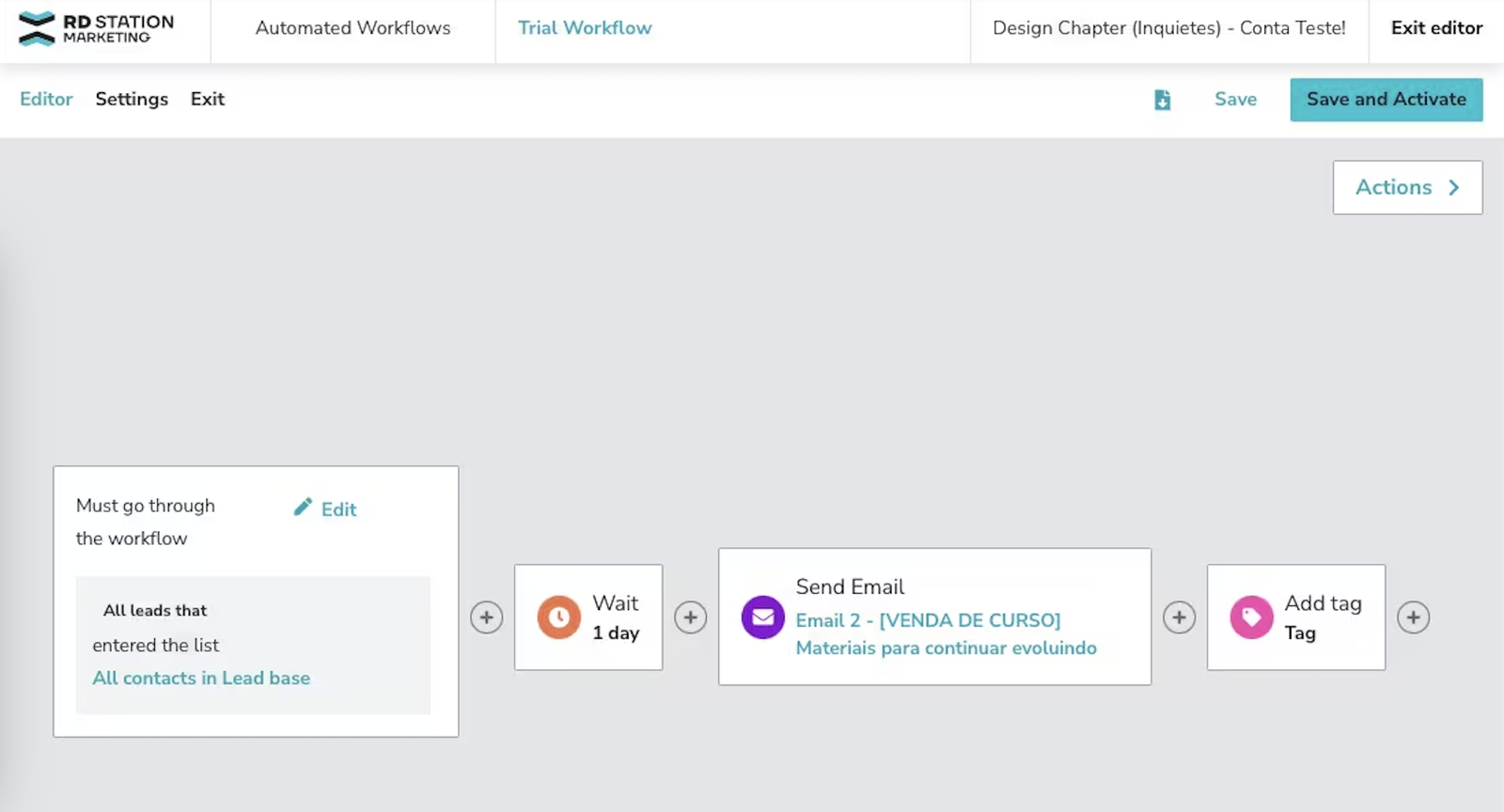
One of its key offerings is pre-built automation templates, which allow small businesses to get started right away. These templates cover common marketing scenarios, saving time and helping businesses implement strategies without needing extensive technical knowledge.
The platform’s automation tools focus heavily on lead nurturing and basic workflows. Users can set up automations tied to specific actions like landing page visits or form submissions, ensuring that leads are captured and followed up in a timely manner.

A trigger set up through Zapier.
In addition, RD Station includes essential tools for email marketing and lead management. Businesses can create and send email campaigns to engage leads and track their interactions. While effective for straightforward tasks, RD Station lacks the advanced triggers and multi-step workflows that platforms like ActiveCampaign offer, limiting the depth of personalization and automation possibilities.
Overall, RD Station is ideal for businesses that prioritize simple lead capture and follow-up. It’s perfect for small to mid-sized companies that need basic automation without diving into complex workflows or advanced marketing strategies.
You can’t get better than placing 1st in deliverability
What good is your email campaign if nobody sees it? From the past three deliverability tests EmailTooltester ran this year, ActiveCampaign scored first over all other platforms with a 93.4% deliverability rate.

During their test, EmailTooltester found that the average deliverability rate among the email service providers tested was 83.1%. That means 16.9% of all emails never reach their intended destination.
A better deliverability rate means more of your contacts will see the emails you send, increasing your chances of interaction (and hopefully conversion). ActiveCampaign is clearly the go-to email platform if you care about deliverability.
And you should, because an undelivered or lost to the spam folder email is practically useless.
Powerful email marketing vs. solid essentials
To start, ActiveCampaign offers 250+ pre-built templates with advanced editing options and the ability to save reusable content blocks. These templates are fully customizable, allowing users to adjust layouts, colors, fonts, and content to match their branding. The drag-and-drop email designer makes this process accessible, even for those with minimal design experience.
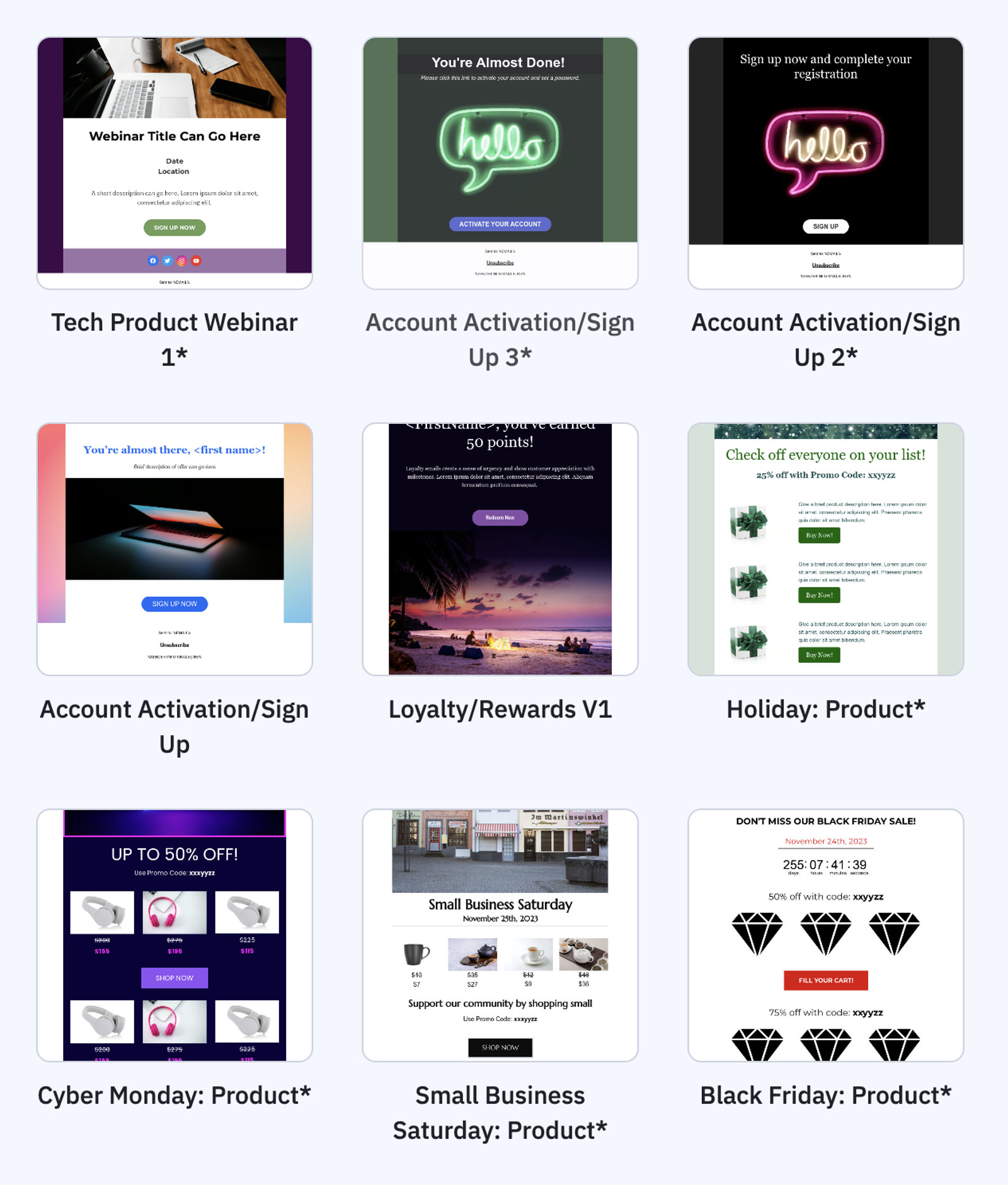
Plus, these templates can be tailored with conditional content, allowing more complex designs that adapt to each contact’s information.
ActiveCampaign is known for granular segmentation, allowing you to create highly targeted lists based on behavior, location, purchase history, and much more. You can use advanced segmentation criteria like page visits, email engagement, and even lead scores, which means you can create specific segments and reach the right audience with precise messages.
Tags allow you to label contacts based on specific characteristics or actions. You might tag contacts as “Newsletter Subscriber,” “VIP Customer,” or even “Webinar Attendee.” These tags are highly customizable and let you easily group contacts for targeted marketing.

ActiveCampaign also allows you to create custom fields that capture specific information about each contact, such as location, birthday, or preferences. You can then use this data to create more personalized messages. For example, you might create a custom field for “Favorite Product,” allowing you to tailor your emails around that specific interest.
Dynamic content lets you personalize specific sections of emails based on each contact’s details, behaviors, or tags. For instance, you can show one message to new subscribers and another to returning customers within the same email.
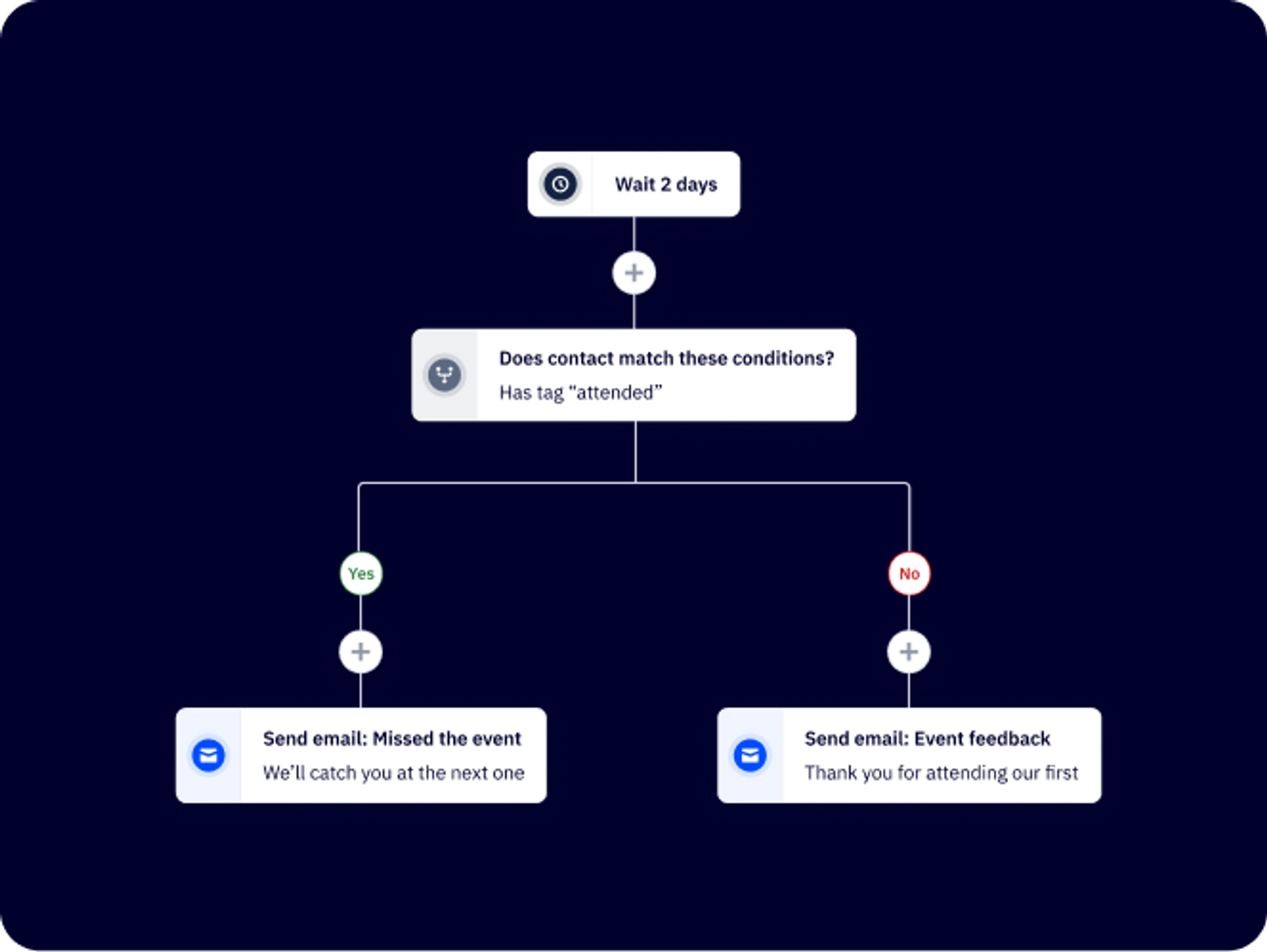
You’ll also get to use dynamic segments. These are lists that automatically update based on set criteria. For instance, you could create a segment of contacts who opened an email in the past month. This feature ensures that your lists are always relevant without constant manual updates.
With ActiveCampaign’s conditional content, you can personalize specific sections of an email based on each contact’s data or behavior. For instance, if a customer has shown interest in a particular product category, you can set the email to display relevant product recommendations just for them.

This means different subscribers can see tailored messages, images, or offers in the same email based on criteria like past purchases, location, or engagement level. It’s a powerful way to ensure each contact gets a message that feels uniquely relevant to them, boosting engagement.
RD Station also offers a variety of pre-built email templates to help users get started quickly. These templates cover different purposes, from newsletters to promotional emails, and can be easily customized with your branding and messaging. This makes it simple for businesses to create polished campaigns without starting from scratch.
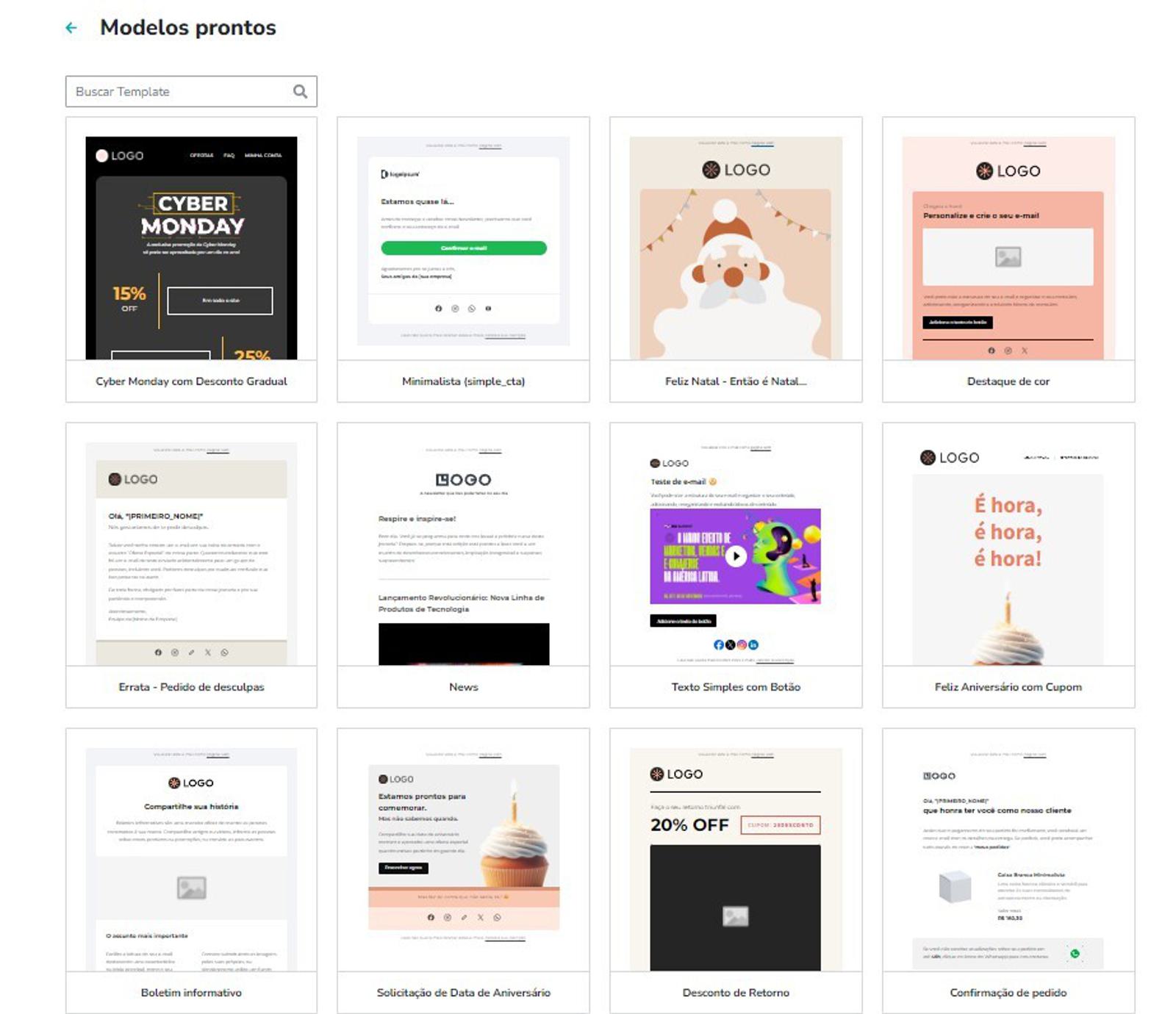
Users can personalize their emails by editing content, images, colors, and layout elements. The platform provides a drag-and-drop editor, allowing for quick adjustments to match your brand’s look and feel. While customization options are straightforward, they’re flexible enough to meet the needs of most small to mid-sized businesses.
RD Station’s segmentation tools let you organize contacts based on specific criteria like form submissions, purchase history, or engagement levels. This allows for targeted campaigns that speak directly to different audience segments, helping you boost engagement and conversions.

With the platform’s A/B testing functionality, you can experiment with different email elements such as subject lines and content to see what resonates most with your audience. While the testing options are more focused on simple variables, they still provide valuable insights that can help you refine your strategy over time.
Similar to ActiveCampaign, RD Station integrates email marketing with its automation workflows, making it easy to trigger personalized emails based on user actions, like signing up for a form or visiting a specific page. This helps businesses nurture leads and maintain engagement without needing to manage every interaction manually.
The platform offers email performance tracking, including key metrics like open rates, click-through rates, and unsubscribes. These insights allow businesses to monitor the effectiveness of their campaigns and make adjustments as needed to improve results.
Overall, RD Station is a good choice for small to mid-sized businesses focused on simple, effective email strategies that integrate seamlessly with their broader marketing efforts.
For businesses seeking powerful email marketing tools with advanced customization, segmentation, and optimization features, ActiveCampaign is typically a better choice.
Integrated CRM for sales and marketing vs. marketing-focused CRM
ActiveCampaign’s integrated CRM is designed to bridge the gap between marketing and sales, offering an integrated solution that enhances both lead management and customer relationship efforts.
Contact management is central to their CRM, allowing you to store and organize customer data in a central location. You can track each contact’s interactions, purchases, and engagement with your emails or website.
Plus, custom fields let you capture specific information about each contact, which helps tailor your communication and create more personalized experiences.
A standout feature of ActiveCampaign’s CRM is its sales automation. With automation, you can set up triggers that respond to a contact’s actions, such as opening an email or filling out a form. This helps you create automatic follow-up emails, task assignments, or reminders.
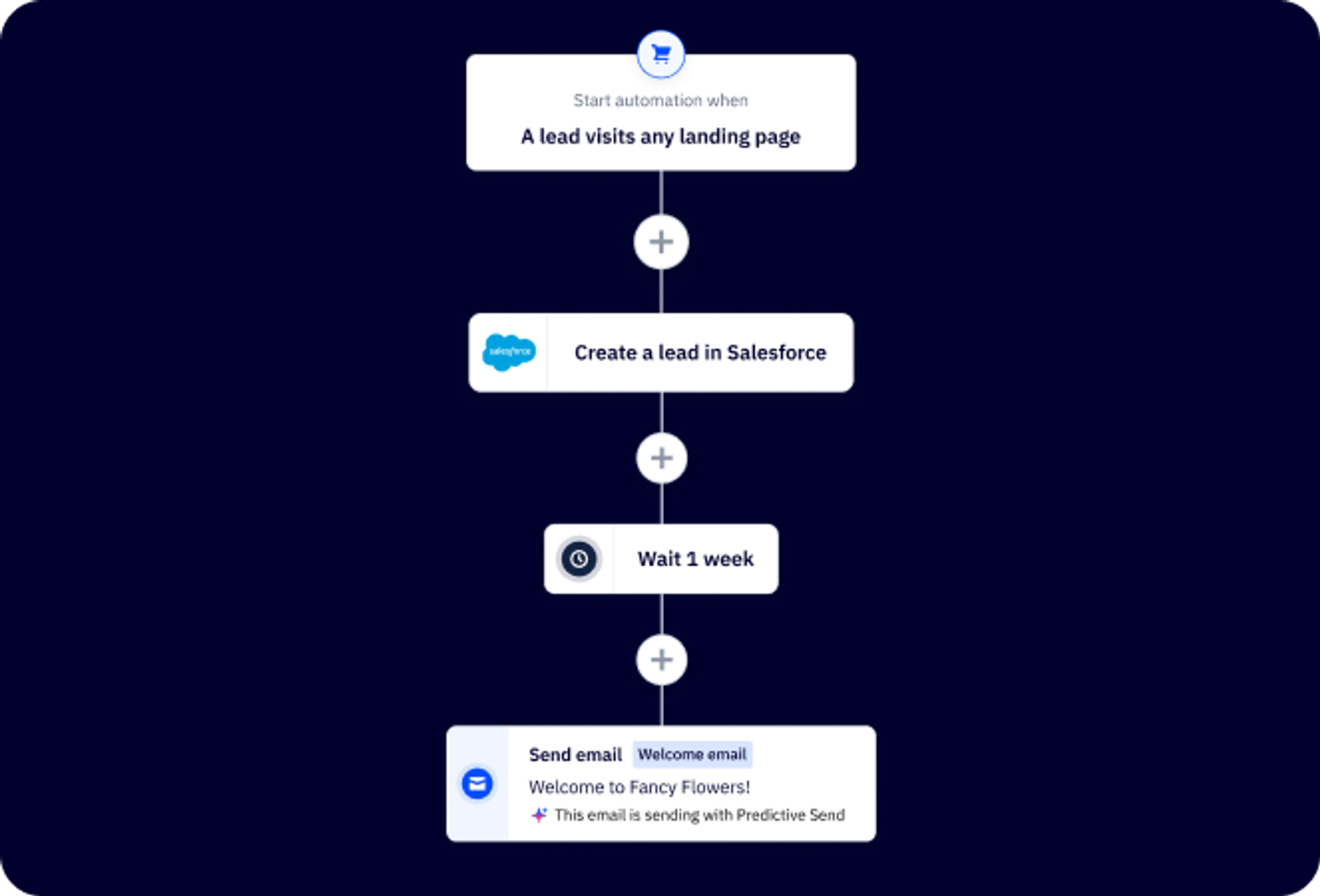
ActiveCampaign allows you to set up automated workflows for deal management, which means that when a lead takes a certain action—like submitting a form, opening a specific email, or clicking a link—they can automatically be assigned a deal status or even moved through different stages of the sales pipeline.

How you’d use it: Say a prospect fills out a request for a demo. You can set up an automation that automatically creates a new deal for that contact in your pipeline, assigns it to a salesperson, and sends them a notification.
By automating these steps, sales teams don’t have to worry about manually moving deals or assigning leads, which minimizes human error and ensures every lead is handled correctly.
Plus, you can use deal tracking and task management to keep your sales process moving smoothly. You can assign tasks to team members, set reminders, and track deal progress from start to finish. The activity timeline gives you a complete view of each contact's journey, including past communications, opened emails, and any sales activities. This level of detail is powerful for sales teams, ensuring they have all the information needed to close deals effectively.

ActiveCampaign also offers an extensive library of automation recipes covering a wide range of marketing and sales needs, making it easy to get started with automated workflows. These recipes are designed for common tasks like welcome sequences, lead nurturing, abandoned cart recovery, post-purchase follow-ups, win-back campaigns, and more.
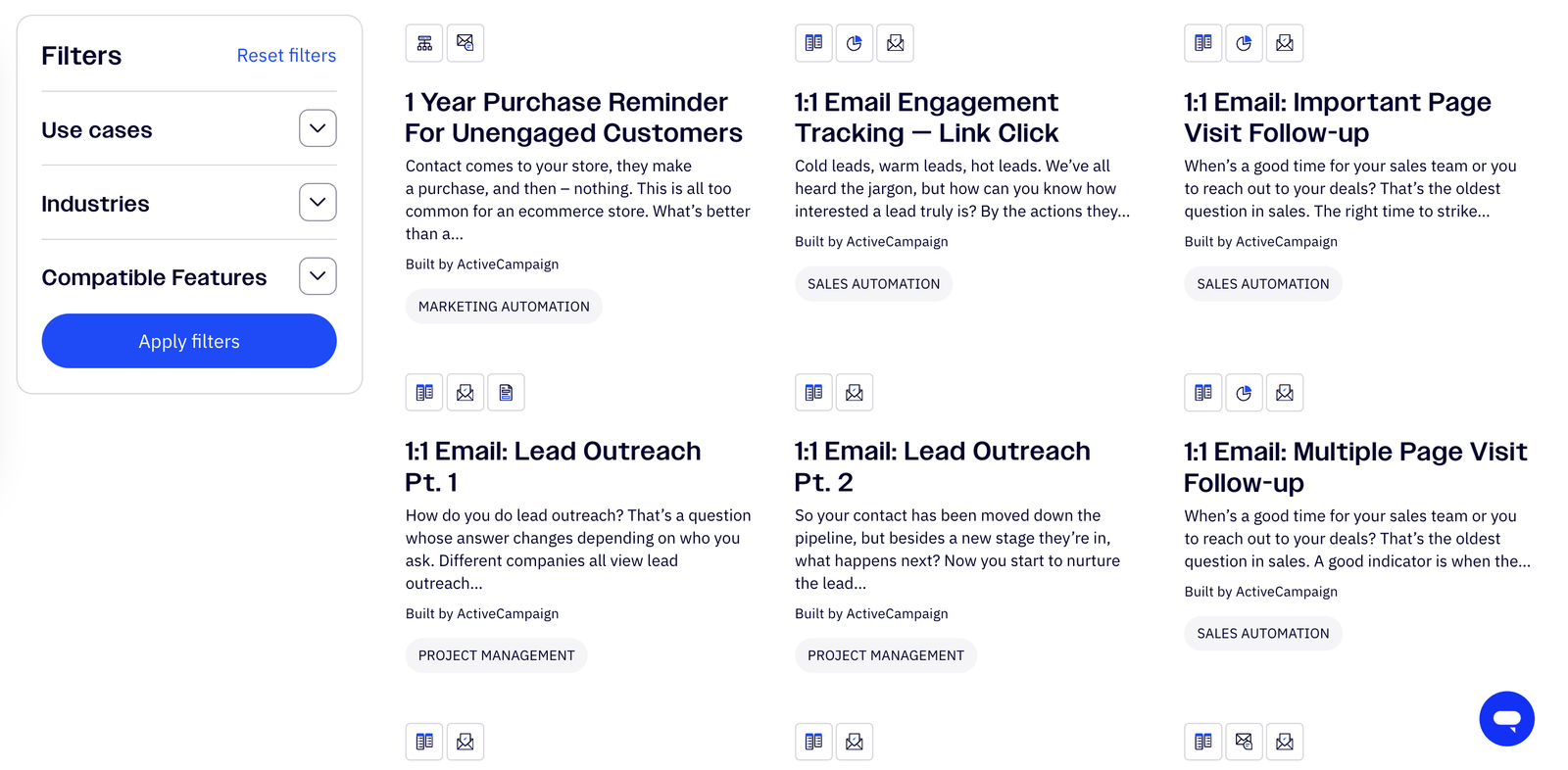
Each recipe provides a ready-made structure complete with suggested triggers, actions, and conditions, so you can quickly customize them to fit your specific goals.
For instance, the welcome email sequence recipe helps new subscribers get familiar with your brand, while the lead scoring template automatically assigns scores to contacts based on engagement, enabling you to prioritize leads. There are also recipes for customer journeys that incorporate multiple channels (like email, SMS, and site tracking), which is useful if you’re aiming for a cohesive experience across different touchpoints.
Key features of ActiveCampaign’s CRM:
- Send a notification or Slack message when a contact’s information changes or they complete specific actions.
- Track and divide up the sales outreach process between different members of your team.
- Set up automations to send relevant content to your customers based on things like order size or response times.
- Use Kanban-style boards to visualize sales opportunities.
- ActiveCampaign’s lead scoring helps you find the most promising opportunities based on your prospects’ actions and behaviors.
- The deal scoring feature gives each of your deals a numerical value so you can understand which deals are a priority.
- Use automations to create and modify deals in the CRM based on the data you’ve already collected from each contact.
RD Station’s CRM, while functional, is more focused on managing customer relationships from a marketing perspective. It provides basic tools for tracking customer interactions and managing leads.
Their CRM allows you to centralize lead information and track their journey through the sales funnel. You can add notes, categorize leads, and monitor key touchpoints, which makes it easier to organize follow-up actions and prioritize prospects effectively. While comprehensive, this feature is ideal for businesses focused on nurturing marketing-qualified leads rather than complex sales processes.
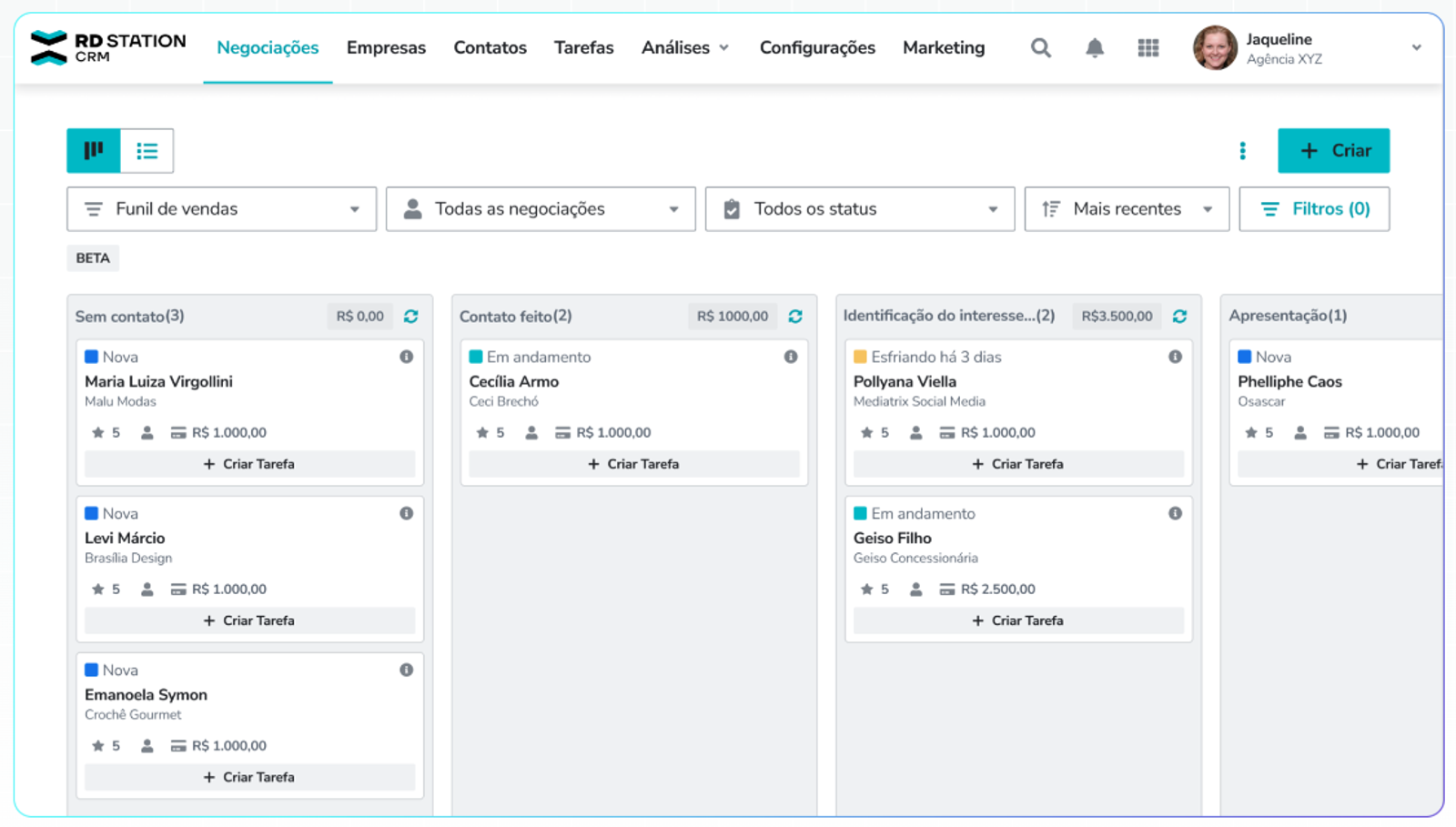
You can create and customize sales pipelines, giving you control over each stage of the customer journey. This helps visualize where leads are in the process and identify bottlenecks. The simplicity of this feature makes it user-friendly but may not offer the depth of customization available in more advanced CRMs.
A standout feature is its integration with WhatsApp via the WhatStation extension. This allows you to interact with leads directly within WhatsApp, update CRM data, and streamline communications without switching platforms. This is a helpful tool for teams that rely on real-time messaging to nurture leads and close deals.
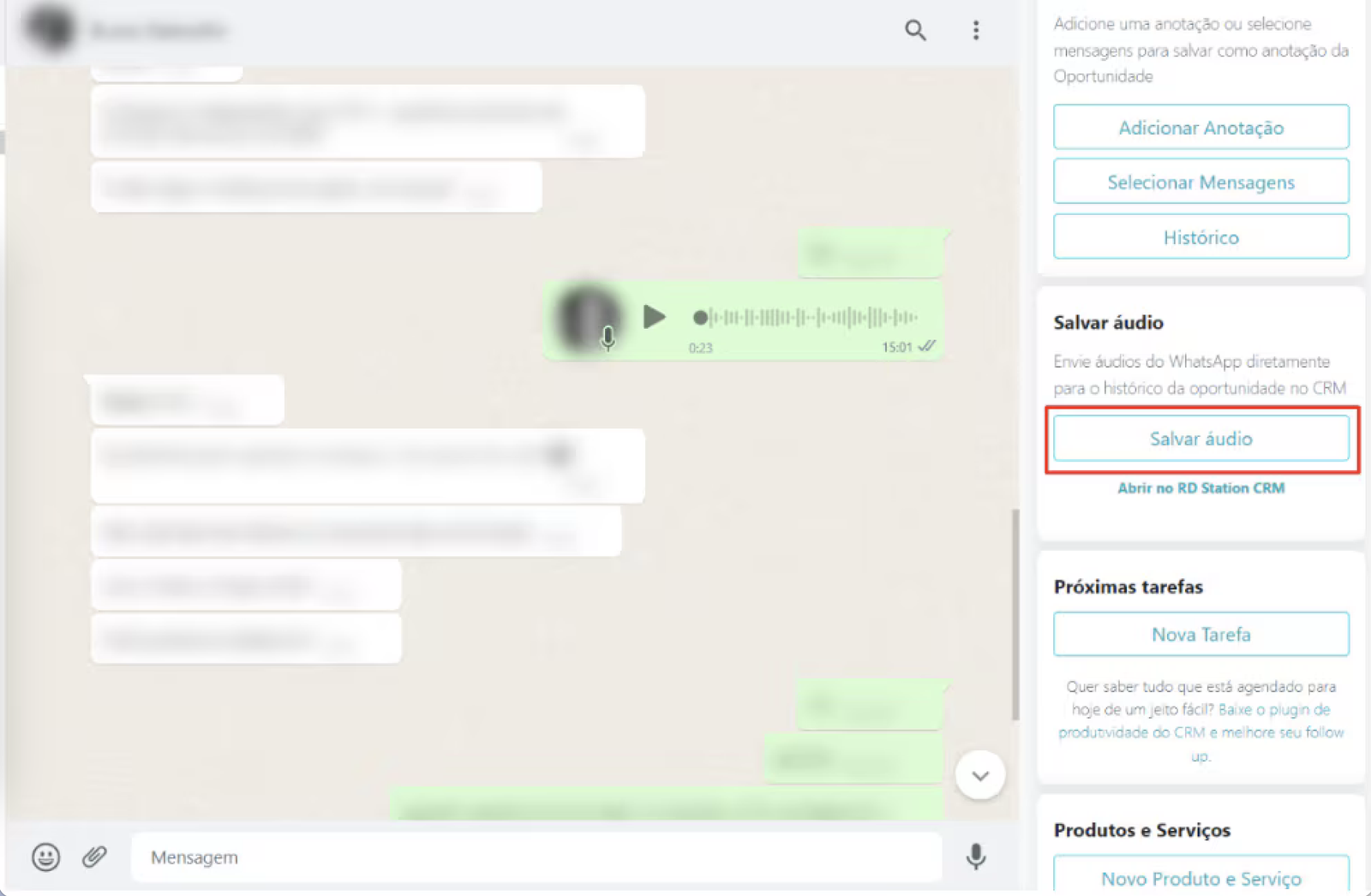
Save audio from WhatsApp into the RD Station CRM.
Basic automation features let you set reminders and automate repetitive tasks like follow-ups and data updates. While useful for simplifying daily operations, these automation capabilities are geared more towards smaller teams needing straightforward workflows.
RD Station CRM provides tools for tracking sales goals and generating performance reports. These reports help teams understand their progress and make data-driven decisions. It’s important to note that their reporting is more focused on marketing metrics than in-depth sales analytics, which might require additional tools for deeper insights if needed.
Versatile lead generation vs. specialized lead capture tools
ActiveCampaign offers solid lead generation tools integrated into its broader platform, including forms and landing pages. This integration ensures a smooth transition from lead capture to conversion, making it a powerful solution for businesses that value an all-in-one approach.
ActiveCampaign’s landing page builder allows you to create highly customized and dynamic landing pages. It comes with a drag-and-drop editor and the power to build pages that include conditional content and integrate seamlessly with your CRM data.
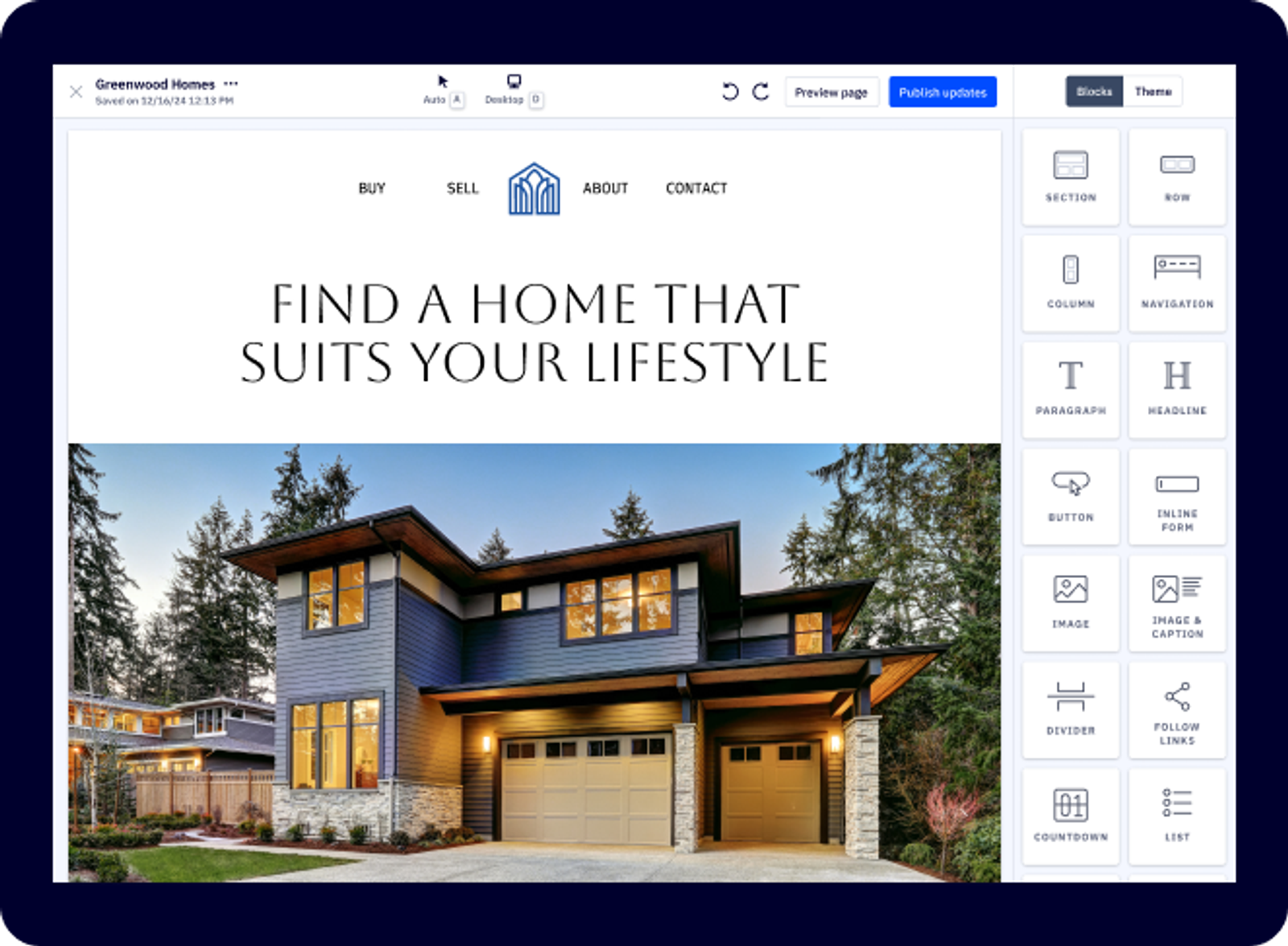
This means you can personalize landing pages based on user behavior and contact information, which is great for targeted campaigns.
In general, ActiveCampaign’s builder provides great flexibility by providing deeper customization options and more advanced features. You can create highly tailored landing pages that integrate with your automations and incorporate dynamic content that will change based on who’s viewing the page.
The builder offers a wider range of design options, including custom code, advanced styling, and more control over layout elements. Additionally, ActiveCampaign supports more advanced A/B testing and analytics directly tied to your email and automation campaigns, giving you a more comprehensive view of how your landing pages perform.
Key features of the ActiveCampaign landing page builder:
- Quickly collect opt-in information from leads
- Add forms to your page and generate qualified leads
- Broaden your reach with ActiveCampaign’s landing page design service (complimentary for accounts on the Plus, Professional, and Enterprise plans)
With ActiveCampaign, you can create a variety of forms, including inline forms, floating bars, floating boxes, and modals (pop-ups), all through a user-friendly drag-and-drop builder. They can be embedded, linked to, and added directly to WordPress or Facebook if you have the integrations set up. Plus, you can associate forms with lists, tags, and deals to tie them to specific campaigns.
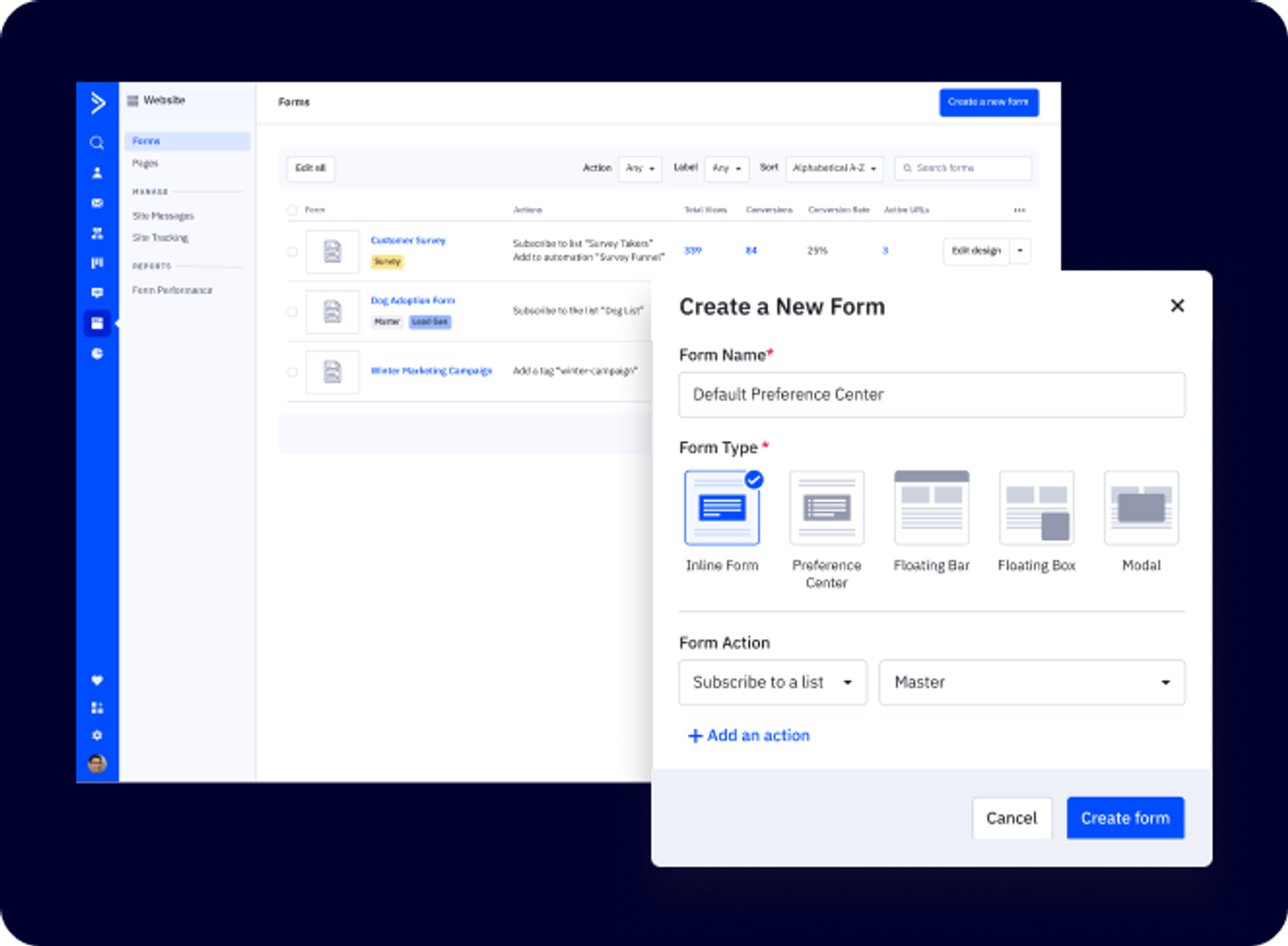
What sets ActiveCampaign apart is its ability to integrate deeply with CRM data and automations, allowing for highly personalized and dynamic forms. You can customize forms based on user behavior, segment contacts as they submit, and trigger specific actions within your automations.
RD Station places a strong emphasis on lead generation, offering a variety of dedicated tools designed to help businesses capture and nurture leads effectively.
Their landing page builder is designed to help you create visually appealing, conversion-focused pages without needing technical skills. You can use customizable templates and drag-and-drop elements to build pages that align with your brand and capture leads effectively. While straightforward, it allows for integration with your marketing campaigns, making it easier to funnel visitors into your sales process.
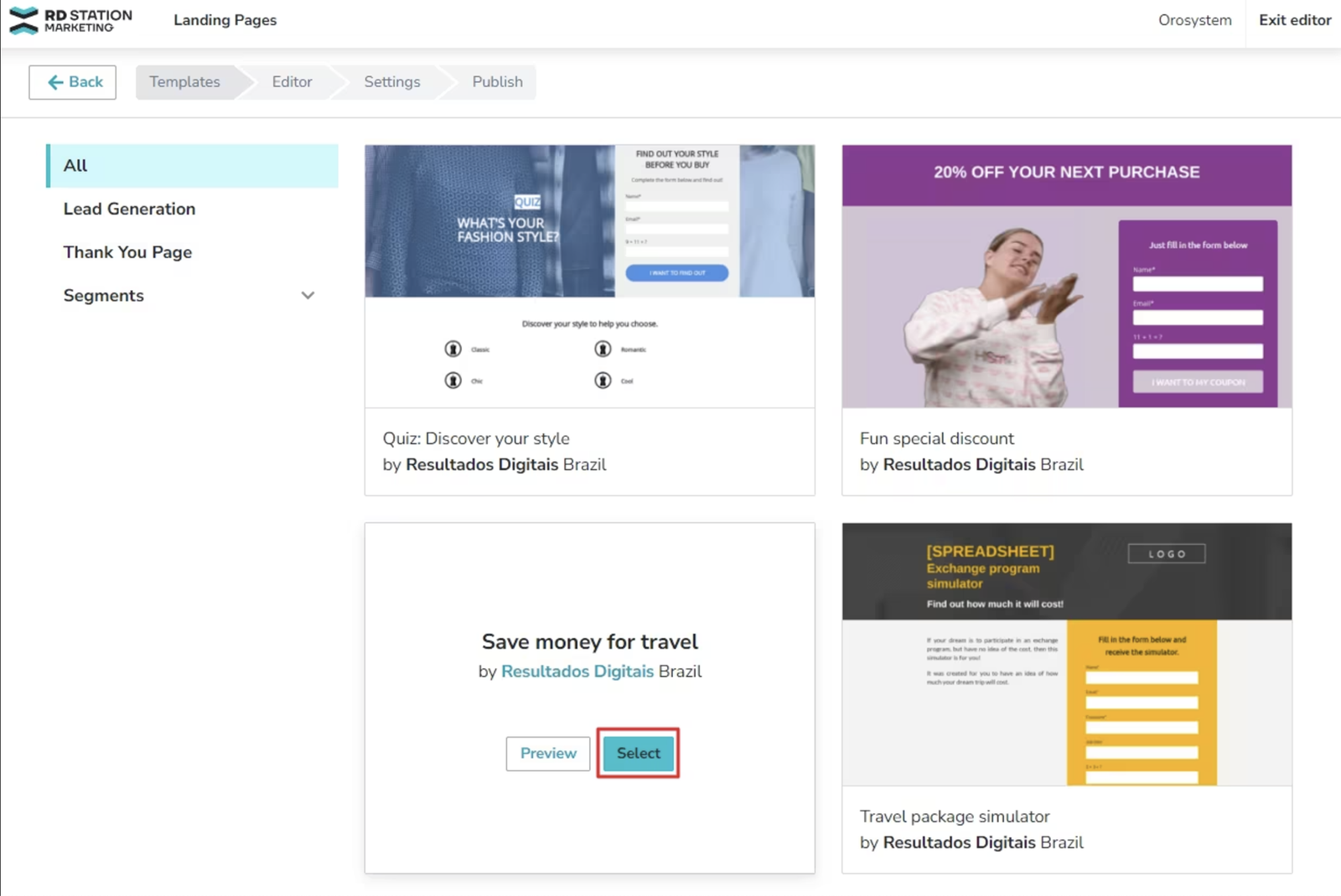
Forms are a core feature of RD Station’s lead capture strategy. You can embed forms on your website or use them within landing pages to collect contact information from potential customers. The forms are customizable, allowing you to gather specific data points that matter most to your business. While not as advanced as some platforms, they integrate well with RD Station’s CRM and automation tools for smooth data management.
RD Station allows you to connect your social media accounts, enabling you to run lead generation campaigns across platforms like Facebook and Instagram. You can capture leads directly from social ads and sync them into your CRM for follow-up. This is integral in broadening your reach and capturing leads from various channels.
Once leads are captured, RD Station’s lead scoring helps prioritize them based on engagement and behavior.
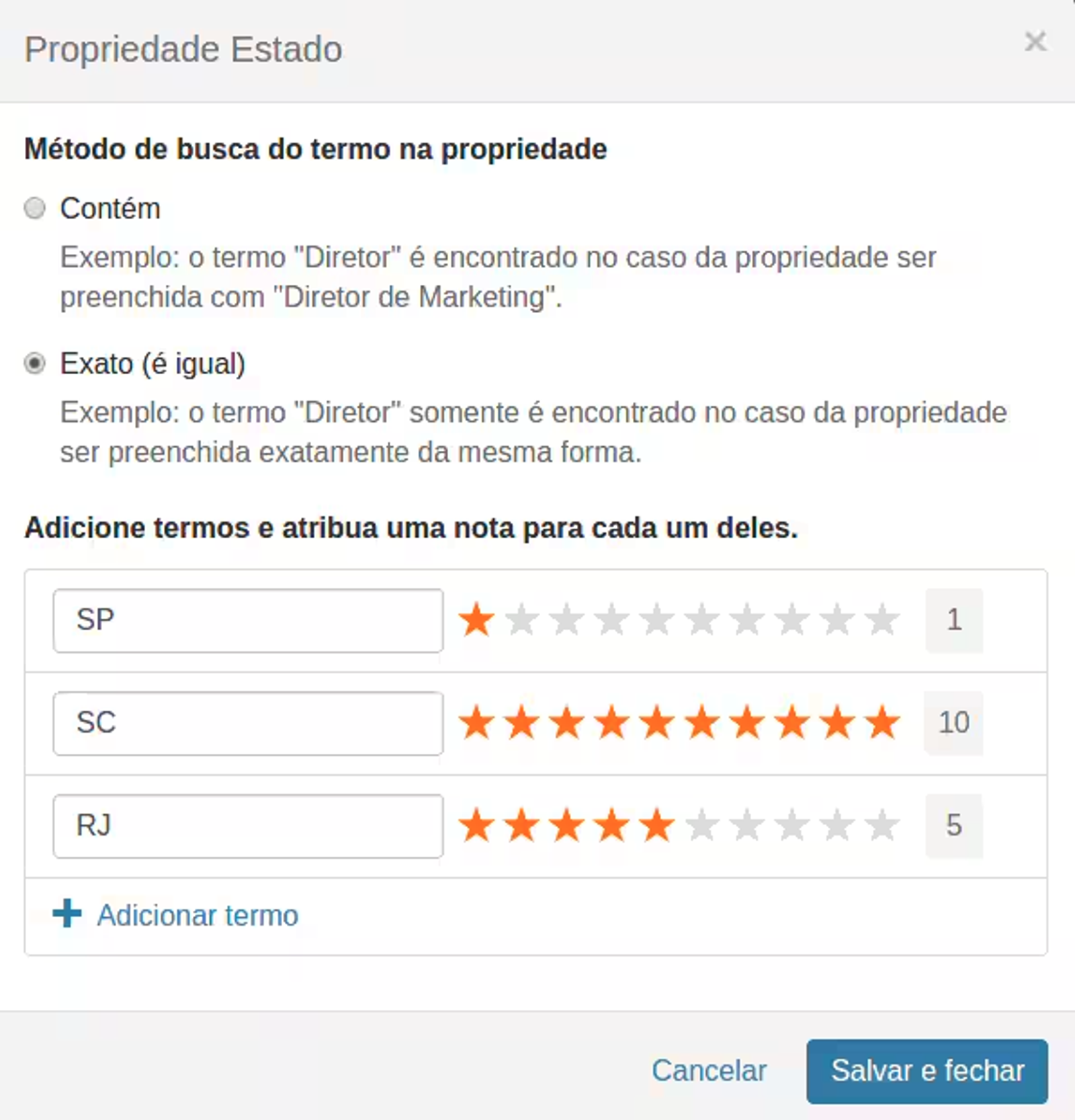
You can assign scores based on actions like form submissions or email opens, making it easier to focus on high-quality prospects. While useful, the scoring system is more basic compared to platforms with more advanced AI-driven insights.
For businesses where lead generation is the primary focus, RD Station offers strong, tailored tools that may provide a slight edge due to its specialized approach in this area. While ActiveCampaign is still effective in lead generation, it excels more in automation and CRM, making it a better choice for businesses seeking a comprehensive solution.
Integrations: 970+ vs. 161
In ActiveCampaign’s app marketplace, you’ll find 970+ apps that integrate with various tools and platforms, including CRM systems, e-commerce platforms, and other marketing tools. It supports connections with popular services like Salesforce, Shopify, WooCommerce, and hundreds more.
RD Station offers substantially fewer integrations, 161 in total. Their integrations include apps like AirTable, Eventbrite, Facebook Lead Ads, LinkedIn Lead Gen Forms, and more.
The platform that’s right for you will ultimately come down to which tools you’re already using and if ActiveCampaign or RD Station can easily integrate with them. By and large, ActiveCampaign offers more flexibility and power when connecting all your apps together (which makes every function a lot easier).
Pricing breakdown
Both ActiveCampaign and RD Station have a few different pricing tiers to choose from. And if you’re wondering if they offer free trials, they do. The only difference is that ActiveCampaign’s is for 14 days and RD Station’s is only for 10 days.
Let’s dig into each platform’s pricing a bit more.
RD Station pricing
RD Station’s entry-level pricing starts with the Light plan. It costs $18/month for up to 1,000 active contacts with a no lock-in contract.
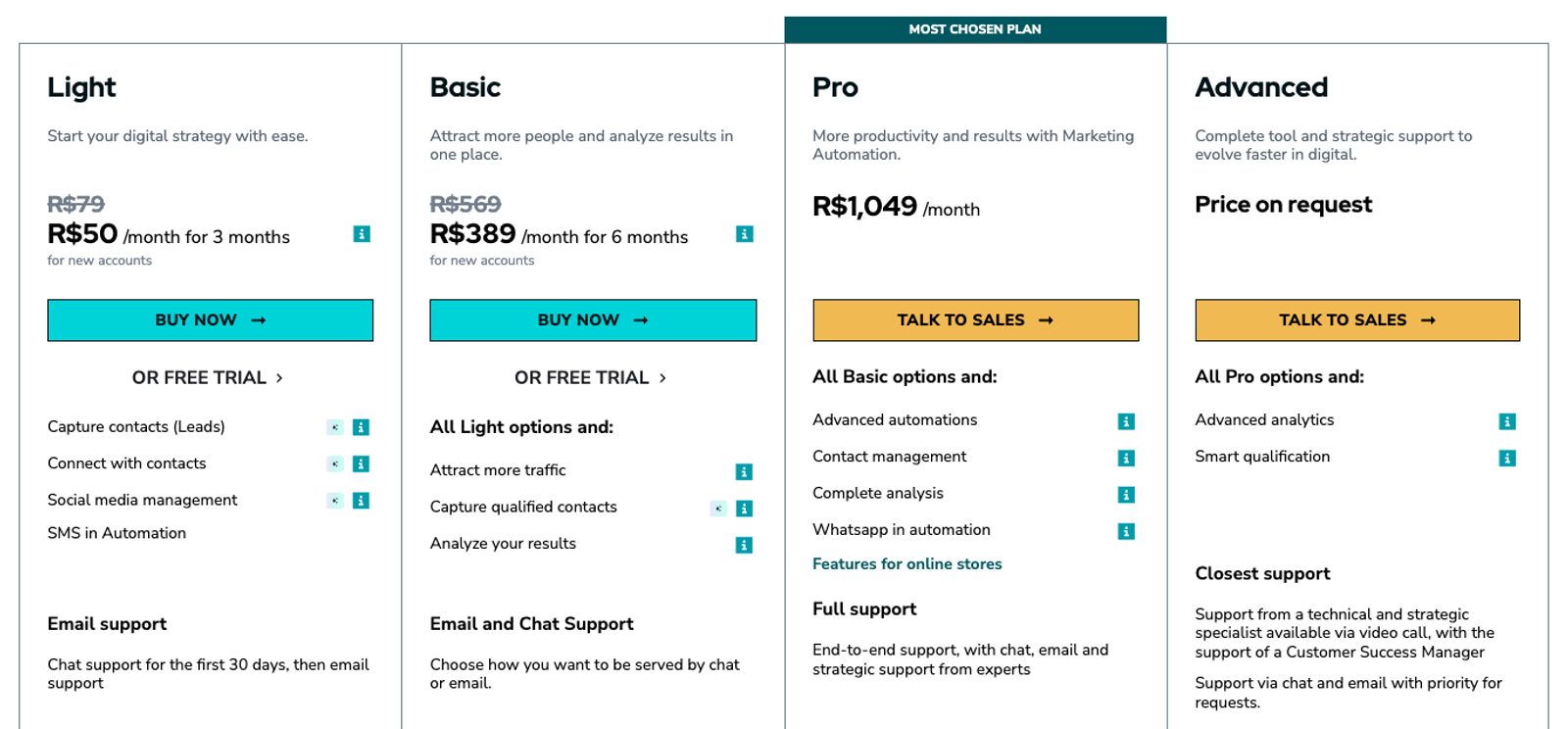
With the Light plan, you have access to the following features:
| Unlimited monthly email sends | Landing page builder and manager |
|---|---|
| Custom fields | Pop-ups |
| Personalized Whatsapp button | Drag-and-drop editor and email campaign manager |
| Lead base | Lead engagement |
| Email templates | Output integrations |
| Basic marketing automation | 120/minute automation request limit |
| API for integrations | Unlimited number of registered users |
| A dedicated IP address for a fee |
The next tier is the Basic plan which will cost you $112/month for up to 5,000 active contacts.
With the Basic plan, you have access to everything in Light, plus:
| Webpage optimization | Post calendar and scheduling |
|---|---|
| Up to 100 keywords on a Semrush keyword dashboard | Limited traffic sources and conversion charts |
| Growth metrics | Analytics for most visited pages |
| Form builder |
RD Station’s final tier is their Pro plan which will cost you $269/month for up to 5,000 active contacts. With it, you’ll have the option to add personalized onboarding for an additional $535 fee.
With the Pro plan, you have access to everything in Basic, plus:
| Smart forms | Lead segmentation |
|---|---|
| Up to 200 keywords on a Semrush keyword dashboard | Advanced marketing automation |
| Landing page A/B testing | Lead scoring |
| Lead tracking | Email A/B testing |
| Daily and weekly reports | Visitor, lead, and customer charts |
| Traffic sources and conversion charts | Success plans |
| 12 months of visitor history storage time | Contact database limit of 26x the number of lead tracking events stored per month |
If you need your email platform to come with advanced marketing automation and A/B testing on emails, you won’t get that unless you choose the Pro plan. On the other hand, ActiveCampaign’s plans come with both on every plan.
If you’re more focused on lead scoring, ActiveCampaign may not be the best fit as it doesn’t offer it on the Starter plan and their CRM is an add-on. The tool you choose will depend on the specific features that are make or break to achieve your business goals.
ActiveCampaign pricing
Compared to similar enterprise-level automation tools like HubSpot or Salesforce, ActiveCampaign is pretty budget-friendly for the features you get. They don’t offer a free plan (just a free two-week trial), but their Starter plan gives you access to some pretty advanced features for only $15/month.

Prices above are based on a max of 1,000 contacts.
ActiveCampaign’s entry-level pricing starts at $15/month for 1,000 contacts. This plan, aptly named the Starter plan, gives you access to multi-step marketing automation right out of the gate.
With ActiveCampaign’s Starter plan, you get access to features like:
| Email sends 10x contact limit | 900+ automation recipes |
|---|---|
| 5 actions and triggers per automation | An AI-powered automation builder |
| Email campaigns and newsletters | Limited reporting and analytics |
| Basic and inline web forms | Limited segmentation |
| Over 970 integrations, including standard e-commerce apps | The ActiveCampaign Marketing CRM |
| Over 250 email templates | A/B testing on emails |
| Site tracking |
Moving up to the Plus plan, you unlock more automation and powerful customer insights for $79/month with 1,000 contacts.
The Plus plan adds features like:
| Unlimited triggers and actions for your automations | Prospecting and retargeting ads for Google, Facebook, and LinkedIn |
|---|---|
| Web forms | Basic segmentation |
| Generative AI functionality | Landing pages (and templates) |
| Basic reporting and analytics | And revenue reporting |
With the Plus plan and up, you can add on the pipeline enhanced CRM to manage your sales automation or the sales engagement CRM that includes additional email and AI capabilities.
ActiveCampaign’s Pro plan will cost you $79/month with 1,000 contacts. With it, you unlock full omnichannel marketing automation. This is where you can truly elevate your email marketing. Your monthly email sends are 12x your contact limit, and you’ll get three users instead of one.
The Pro plan gives you access to additional features like:
| A/B testing on automations | Conditional content |
|---|---|
| Predictive sending | Advanced segmentation, reporting, and analytics |
| Attribution and conversion tracking |
The Pro plan helps you get more granular about how your email campaigns are performing and understand what content, messaging, and offers move the needle for your business. You’ll have total control over your email cadence.
Finally, ActiveCampaign’s Enterprise plan starts at $145/month for 1,000 contacts and allows you monthly email sends 15x your contact limit plus five users.
With the Enterprise plan, you get everything previously mentioned, plus:
| Premium segmentation | Custom objects |
|---|---|
| Premium CRM integrations with Salesforce, Microsoft Dynamics, and more | Premium reporting and analytics |
| Single sign-on (SSO) | And a dedicated account team |
No matter which ActiveCampaign plan you choose, ActiveCampaign offers services like contact migration, customer enablement workshops, chat and ticket support, video tutorials, a knowledge base, and help guides to help you get the most out of the platform so you can focus on running your business.
ActiveCampaign or RD Station: which is best for you?
The platform you choose will depend on which features above are most important to you (and which you need to grow your business).
Choose ActiveCampaign if you want to level up your marketing with advanced automation, personalized customer journeys, and a powerful CRM that scales as you grow.
Choose RD Station if you’re looking for simple, lead-focused tools to capture and nurture leads without the need for complex marketing or sales automation.
While RD Station offers some advantages, particularly in lead generation and local market expertise, ActiveCampaign is the clear winner for businesses looking for a comprehensive, user-friendly platform that excels in automation, email marketing, and CRM capabilities.
What are real customers saying about each platform?
Are customer stories too biased for you? We get it. Let’s look at a few reviews from real users.
| Pros: Easy and ready to use, on the fly. Some good templates for the beginner marketing team. | Cons: Very limited customization, lack of social media good tools, and an expensive price for a larger contact list. |
|---|
| Pros: We were able to roll AC out to our sales team. It was an easy transition thanks to a beautiful interface and endless resources. ActiveCampaign is small enough to be an easy on-ramp for a small company but can scale to any size. | Cons: I started on ActiveCampaign with a small company. I would have loved to get more included training or personalized deals pipelines to help get the ball rolling. Integration was incredible easy, but I would have loved more help with getting started. |
|---|
Frequently asked questions
Lingering questions? We've got you.
💡 Who is ActiveCampaign best for?
ActiveCampaign is ideal for businesses that want to take their marketing to the next level with powerful automation and personalization features. It’s a great fit for small to mid-sized teams who need advanced tools to automate their marketing, segment their audience, and track detailed performance metrics.
If you're looking for a platform that offers deep customization, predictive analytics, and a visual workflow builder to create tailored customer experiences, ActiveCampaign could be a perfect match. It’s especially useful if you have a bit of experience with email marketing and want to leverage more sophisticated strategies to drive growth.
💡 Can ActiveCampaign be used as a CRM?
Yes, ActiveCampaign can be used as a CRM. It includes built-in CRM functionalities that allow businesses to manage their sales pipelines, track customer interactions, and automate follow-ups.
The combination of marketing automation and CRM in one platform helps simplify the sales process, improve customer engagement, and maintain organized records of customer data and interactions, making it easy to manage your marketing and sales in one place.
💡 What does RD Station do?
RD Station is a platform designed to help businesses generate, nurture, and convert leads through an array of marketing tools. It offers features like landing page creation, email marketing, CRM, and marketing automation, making it easy for businesses to attract and engage potential customers.
One of its standout strengths is its emphasis on lead generation and nurturing, providing tools to capture contacts and guide them through the sales funnel efficiently.
💡 Does ActiveCampaign integrate with my existing tools?
Yes, ActiveCampaign offers extensive integration capabilities with over 950 tools, including popular platforms like Shopify, WordPress, and Salesforce. Whether you need to integrate with e-commerce platforms, CRM systems, or other marketing tools, ActiveCampaign has a wide range of options to ensure seamless connectivity.
💡 What is the difference between ActiveCampaign and RD Station?
ActiveCampaign is built for businesses that need advanced automation and CRM tools to create personalized customer journeys and manage sales at scale. It’s ideal for companies looking to automate complex workflows across email, sales, and customer follow-ups.
RD Station focuses on lead generation and basic automation. It’s a simpler platform with tools like landing pages and email marketing, perfect for small businesses—especially in Latin America—looking to capture and nurture leads without the need for advanced features.